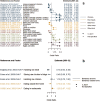A scoping review of factors associated with antimicrobial-resistant Campylobacter species infections in humans
- PMID: 37283142
- PMCID: PMC10311695
- DOI: 10.1017/S0950268823000742
A scoping review of factors associated with antimicrobial-resistant Campylobacter species infections in humans
Abstract
Human infection with antimicrobial-resistant Campylobacter species is an important public health concern due to the potentially increased severity of illness and risk of death. Our objective was to synthesise the knowledge of factors associated with human infections with antimicrobial-resistant strains of Campylobacter. This scoping review followed systematic methods, including a protocol developed a priori. Comprehensive literature searches were developed in consultation with a research librarian and performed in five primary and three grey literature databases. Criteria for inclusion were analytical and English-language publications investigating human infections with an antimicrobial-resistant (macrolides, tetracyclines, fluoroquinolones, and/or quinolones) Campylobacter that reported factors potentially linked with the infection. The primary and secondary screening were completed by two independent reviewers using Distiller SR®. The search identified 8,527 unique articles and included 27 articles in the review. Factors were broadly categorised into animal contact, prior antimicrobial use, participant characteristics, food consumption and handling, travel, underlying health conditions, and water consumption/exposure. Important factors linked to an increased risk of infection with a fluoroquinolone-resistant strain included foreign travel and prior antimicrobial use. Identifying consistent risk factors was challenging due to the heterogeneity of results, inconsistent analysis, and the lack of data in low- and middle-income countries, highlighting the need for future research.
Keywords: Antimicrobial resistance; Campylobacter; antimicrobial drugs; food-borne infections; risk factor.
Conflict of interest statement
The authors have no competing interest.
Figures






Similar articles
-
Emergence of Fluoroquinolone-Resistant Campylobacter jejuni and Campylobacter coli among Australian Chickens in the Absence of Fluoroquinolone Use.Appl Environ Microbiol. 2020 Apr 1;86(8):e02765-19. doi: 10.1128/AEM.02765-19. Print 2020 Apr 1. Appl Environ Microbiol. 2020. PMID: 32033955 Free PMC article.
-
Characterisation of burden of illness measures associated with human (Fluoro)quinolone-resistant Campylobacter spp. infections - a scoping review.Epidemiol Infect. 2022 Nov 11;150:e205. doi: 10.1017/S095026882200139X. Epidemiol Infect. 2022. PMID: 36519309 Free PMC article.
-
Campylobacter species prevalence, characterisation of antimicrobial resistance and analysis of whole-genome sequence of isolates from livestock and humans, Latvia, 2008 to 2016.Euro Surveill. 2019 Aug;24(31):1800357. doi: 10.2807/1560-7917.ES.2019.24.31.1800357. Euro Surveill. 2019. PMID: 31387670 Free PMC article.
-
Antimicrobial resistance mechanisms among Campylobacter.Biomed Res Int. 2013;2013:340605. doi: 10.1155/2013/340605. Epub 2013 Jun 24. Biomed Res Int. 2013. PMID: 23865047 Free PMC article. Review.
-
Fluoroquinolone-resistant Campylobacter infections: eating poultry outside of the home and foreign travel are risk factors.Clin Infect Dis. 2004 Apr 15;38 Suppl 3:S279-84. doi: 10.1086/381597. Clin Infect Dis. 2004. PMID: 15095200
Cited by
-
Antimicrobial Activity of Green Synthesized Silver and Copper Oxide Nanoparticles against the Foodborne Pathogen Campylobacter jejuni.Antibiotics (Basel). 2024 Jul 14;13(7):650. doi: 10.3390/antibiotics13070650. Antibiotics (Basel). 2024. PMID: 39061332 Free PMC article.
-
Genomic resistant determinants of multidrug-resistant Campylobacter spp. isolates in Peru.J Glob Antimicrob Resist. 2024 Mar;36:309-318. doi: 10.1016/j.jgar.2024.01.009. Epub 2024 Jan 24. J Glob Antimicrob Resist. 2024. PMID: 38272215 Free PMC article.
-
Campylobacter coli of porcine origin exhibits an open pan-genome within a single clonal complex: insights from comparative genomic analysis.Front Cell Infect Microbiol. 2024 Oct 2;14:1449856. doi: 10.3389/fcimb.2024.1449856. eCollection 2024. Front Cell Infect Microbiol. 2024. PMID: 39415896 Free PMC article.
-
Occurrence of Florfenicol and Linezolid Resistance and Emergence of optrA Gene in Campylobacter coli Isolates from Tunisian Avian Farms.Int J Microbiol. 2024 Aug 5;2024:1694745. doi: 10.1155/2024/1694745. eCollection 2024. Int J Microbiol. 2024. PMID: 39135629 Free PMC article.
-
High molecular/low acetylated chitosans reduce adhesion of Campylobacter jejuni to host cells by blocking JlpA.Appl Microbiol Biotechnol. 2024 Jan 24;108(1):171. doi: 10.1007/s00253-024-13000-0. Appl Microbiol Biotechnol. 2024. PMID: 38265503 Free PMC article.
References
-
- World Health Organization (2015) WHO Estimates of the Global Burden of Foodborne Diseases 2007–2015 [Internet]. Geneva, Switzerland: World Health Organization. Available at https://apps.who.int/iris/bitstream/handle/10665/199350/?sequence=1 (accessed 28 June 2022).
-
- Thomas MK, Murray R, Flockhart L, Pintar K, Pollari F, Fazil A, Nesbitt A and Marshall B (2013) Estimates of the burden of foodborne illness in Canada for 30 specified pathogens and unspecified agents, circa 2006. Foodborne Pathogens and Disease 10, 639–648. 10.1089/fpd.2012.1389 - DOI - PMC - PubMed
-
- Centers for Disease Control and Prevention (2017) Campylobacter (Campylobacteriosis) [Internet]. Available at https://www.cdc.gov/campylobacter/technical.html (accessed 28 June 2022).
Publication types
MeSH terms
Substances
LinkOut - more resources
Full Text Sources
Medical
Research Materials

